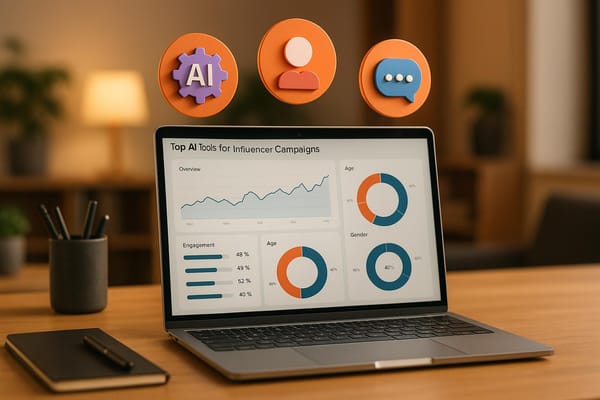Best Media Monitoring Tools: 2025 Roundup
Explore top media monitoring tools for 2025, essential for PR and influencer marketing professionals to track mentions and analyze sentiment.
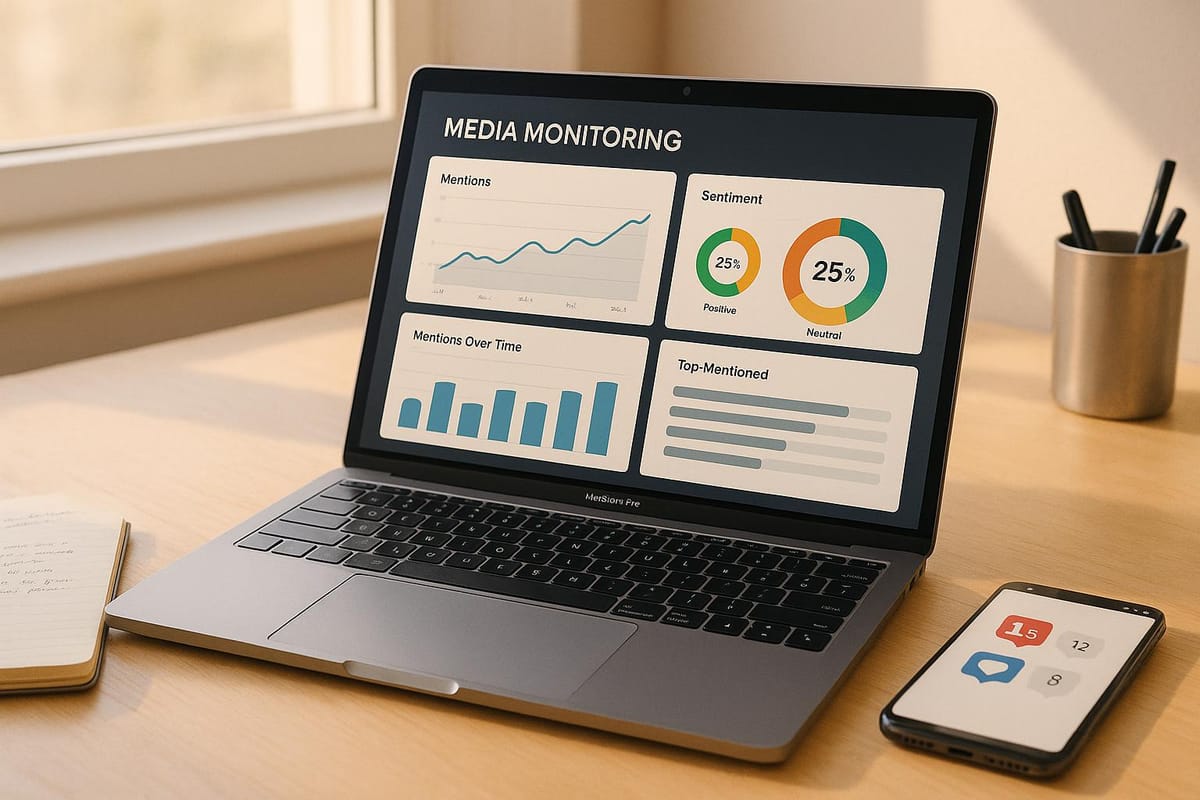
In 2025, media monitoring tools are crucial for PR and influencer marketing professionals to manage brand mentions, track sentiment, and respond to crises. With brands being mentioned online every 3.2 seconds across 2.5 million publications, selecting the right tool can make or break your communication strategy. Here’s what you need to know:
- Core Features: Look for real-time alerts, AI-powered sentiment analysis, multi-platform coverage, advanced filtering, and integration with existing systems.
- Pricing: Options range from $24/month (basic tools like Awario) to $15,000 annually (enterprise solutions like Dataminr).
- Top Tools: Media AI (contact discovery), Brandwatch (social analytics), Meltwater (multi-channel monitoring), and Mention (real-time alerts) cater to different needs and budgets.
- US Market Considerations: Ensure tools cover local media, comply with data privacy laws, and support US date/time formatting.
For smaller teams or targeted outreach, Media AI stands out with its AI-driven journalist and creator database starting at $99/month. Larger enterprises may benefit from platforms like Meltwater or Brandwatch for broader analytics. Evaluate free trials and choose a tool that aligns with your goals and workflow.
5 Best Brand Monitoring Tools In 2025 | Public Relations Guide
How to Choose Media Monitoring Tools
Picking the right media monitoring tool means weighing your specific needs, budget, and workflow. With the global media monitoring tools market projected to grow at a 14.1% CAGR from 2025 to 2030, and North America accounting for 37.0% of the revenue share, businesses in the US have access to a range of advanced tools. The challenge lies in finding one that offers broad coverage, actionable insights, and fits seamlessly into your team's operations.
Core Features to Look For
The best media monitoring tools stand out by offering features that keep pace with today’s fast-moving communication landscape.
- Real-time alerts: These tools scan news outlets, social media, and forums continuously, sending instant notifications to your phone or desktop. This ensures you can respond quickly to breaking news or mentions before they escalate.
- AI-powered sentiment analysis: By analyzing the emotional tone behind mentions, these tools help you track public opinion shifts and understand how your messaging is landing. With 65% of PR professionals now using AI, this feature is becoming a key part of building data-driven strategies.
- Comprehensive platform coverage: A good tool tracks mentions across multiple channels, including traditional media (TV, radio, print), online news, blogs, podcasts, and social platforms. This ensures you’re capturing the full picture.
- Advanced filtering capabilities: Tools with robust filtering options can sift through irrelevant noise, focusing on the conversations that matter most to your brand or industry.
- Customizable dashboards and reporting: Access metrics like share of voice, engagement rates, and trend analysis in a format tailored to your campaigns. This flexibility helps teams focus on what’s most relevant.
- Integration capabilities: Tools that sync with existing systems like CRMs, analytics platforms, and social media management tools streamline workflows and eliminate data silos.
US Market Considerations
When selecting a tool in the US market, there are specific factors to keep in mind:
- Pricing structures: Options range from $24/month for basic tools like Awario to high-end enterprise solutions like Dataminr, which can cost $15,000 annually. Understanding whether a tool offers subscription-based, pay-per-use, or tiered pricing can help you plan your budget and scale as needed.
- Date and time formatting: US standards (MM/DD/YYYY and 12-hour clock) are essential for clear scheduling, especially during time-sensitive situations like crisis communications.
- Local media coverage: For US-based businesses, it’s vital to choose a tool that covers American news outlets, regional publications, and social media conversations. The tool should also account for regional slang and language nuances to ensure accurate sentiment analysis.
- Data protection compliance: With US privacy regulations and corporate security standards in mind, make sure the tool adheres to best practices for handling sensitive content.
PR and Influencer Marketing Setup
Beyond technical specs, a good monitoring tool should support your broader PR and influencer marketing efforts.
- Influencer discovery and analytics: As influencer marketing has surged to an estimated $24 billion in 2024, tools that identify relevant influencers, track their engagement, and analyze their audience demographics are invaluable for outreach.
- Campaign tracking and measurement: Effective tools align with key KPIs like engagement (54%), audience growth (53%), and social interactions (52%), as highlighted in The 2025 Sprout Social Index™. Clear metrics in these areas make it easier to measure success.
- Workflow automation and PR integration: Tools that automate tasks like media summaries, prioritizing mentions, and compiling reports free up time for strategic work. Seamless integration with existing systems ensures smooth campaign execution.
- Competitor monitoring: Tracking competitors’ strategies helps identify opportunities and gaps in their coverage that your brand can capitalize on.
- Crisis communication features: Look for tools that detect sentiment changes, track influential voices, and monitor how information spreads across channels. These capabilities are critical for managing reputation issues or responding to negative press.
The right media monitoring tool doesn’t just track mentions - it amplifies your PR efforts with timely insights and streamlined processes. Prioritize solutions that meet your current needs and can grow alongside your organization as your monitoring demands evolve.
Next, we’ll dive into how Media AI aligns with these criteria by exploring its features, pricing, and practical applications.
Media AI
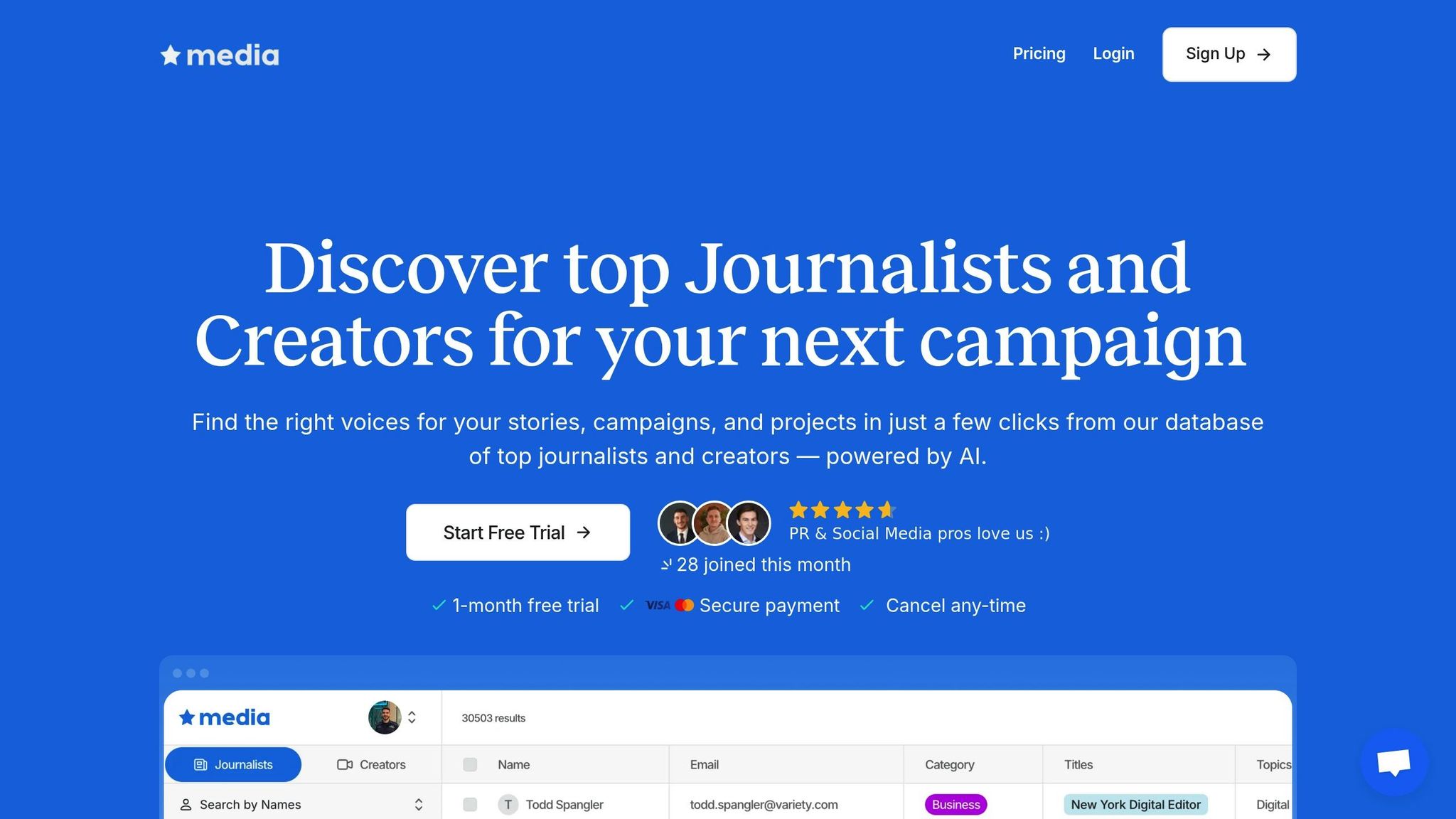
Media AI has become an essential tool in the modern media monitoring arsenal, offering a tailored solution to simplify media outreach. Designed for PR professionals and influencer teams, it provides dependable access to over 30,000 verified journalist and creator contacts through an AI-driven database.
Features and Capabilities
At its core, Media AI leverages a unified, AI-powered database that bridges the gap between traditional PR and influencer outreach. This is especially valuable in today's media landscape, where integrated strategies are key.
The platform’s filtering system allows users to refine contact searches based on criteria like beat coverage, audience demographics, engagement rates, and location. This targeted approach reflects a growing trend in data-driven strategies, with 60.2% of marketers now turning to AI for influencer identification and campaign optimization. Media AI’s intelligent search further enhances this by analyzing content patterns, engagement history, and audience alignment, helping users connect with contacts most likely to respond - potentially increasing conversion rates by up to 20%.
Additionally, its export feature streamlines workflow by allowing users to transfer contact details directly into existing CRM systems or outreach tools. This eliminates manual data entry, accelerating campaign launches. Real-time updates ensure that the database’s 30,000+ contacts remain current and reliable.
Pricing and Plans
Media AI offers a simple pricing model tailored for U.S. businesses, with no long-term commitments required. Subscribers can choose from three plans:
- Journalist Database – $99/month: Access to all journalist contacts
- Creators Database – $99/month: Access to all creator contacts
- Full Database – $149/month: Combined access to journalists and creators
This flexible pricing acknowledges that some teams may focus solely on traditional media or influencer marketing. For agencies managing both, the full database option provides added value at just $50 more. The no-contract policy is particularly appealing, allowing PR teams to scale their usage during busy periods or pause subscriptions during slower months without penalties.
Use Cases
Media AI is designed to tackle key PR challenges with its powerful features and adaptable pricing.
Campaign Planning and Media Outreach is one of its standout applications. PR teams can use the platform to find journalists covering specific beats, from technology to lifestyle and finance. The AI-powered matching system shifts teams away from generic press releases toward personalized outreach, which often leads to better response rates.
Influencer Discovery and Vetting has become increasingly critical as influencer marketing is projected to grow to $32.55 billion globally by 2025. Media AI’s creator database helps brands identify influencers whose audiences align with campaign goals. It also assists in finding micro-influencers in niche markets, enabling more authentic and targeted collaborations.
Crisis Communication Response is another area where Media AI shines. During reputational challenges, PR teams can quickly identify relevant journalists and influencers, allowing for faster, more strategic communication.
Product Launch Coordination benefits from the platform’s dual access to journalist and creator contacts. This integrated approach supports launch strategies that combine traditional media coverage with influencer partnerships and social media amplification.
For agencies and freelancers managing campaigns across diverse industries, Media AI provides a centralized resource, eliminating the need to maintain separate databases. As Gordon Glenister aptly puts it:
AI technology will help drive influencer marketing at scale, manage data better, manage content impact better, and therefore drive better results.
Top Media Monitoring Tools Compared
When it comes to media monitoring, different tools cater to different needs. Media AI shines in targeted contact discovery, while competitors like Brandwatch, Meltwater, and Mention focus on broader analytics and monitoring. Below, we break down how these platforms compare in terms of strengths and limitations.
Brandwatch
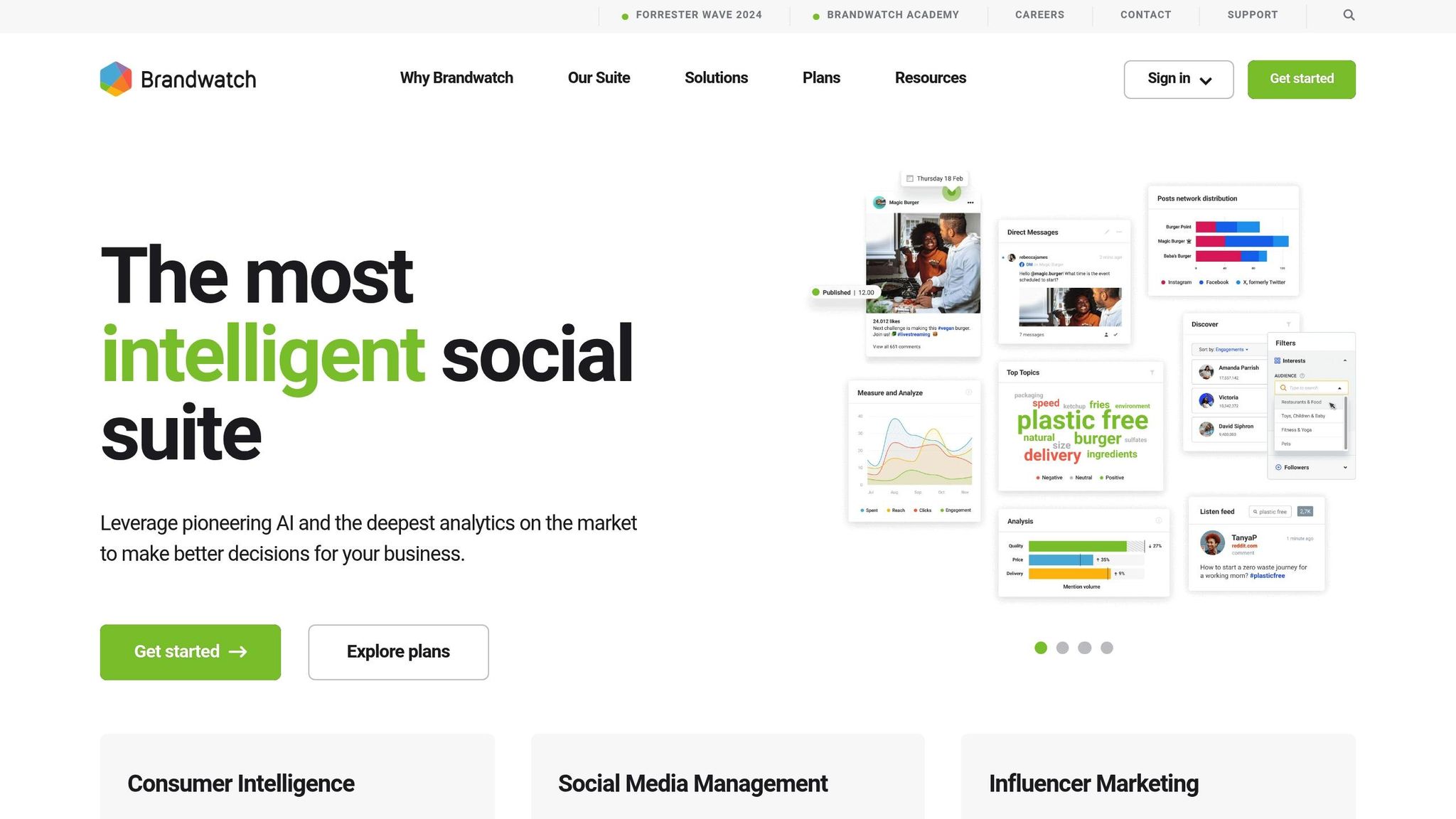
Brandwatch stands out for its strong social analytics and access to historical data. It’s particularly adept at social listening, offering detailed conversation insights and sentiment analysis. Users can set up alerts using simple boolean logic, and features like multi-step approval flows and timezone support make it ideal for global campaigns. However, some users have reported occasional issues with technical reliability and visual analytics. With a 4.35/5 rating from 895 reviews, Brandwatch appeals to large organizations that require in-depth social media intelligence. Pricing is custom and tied to annual contracts.
Meltwater
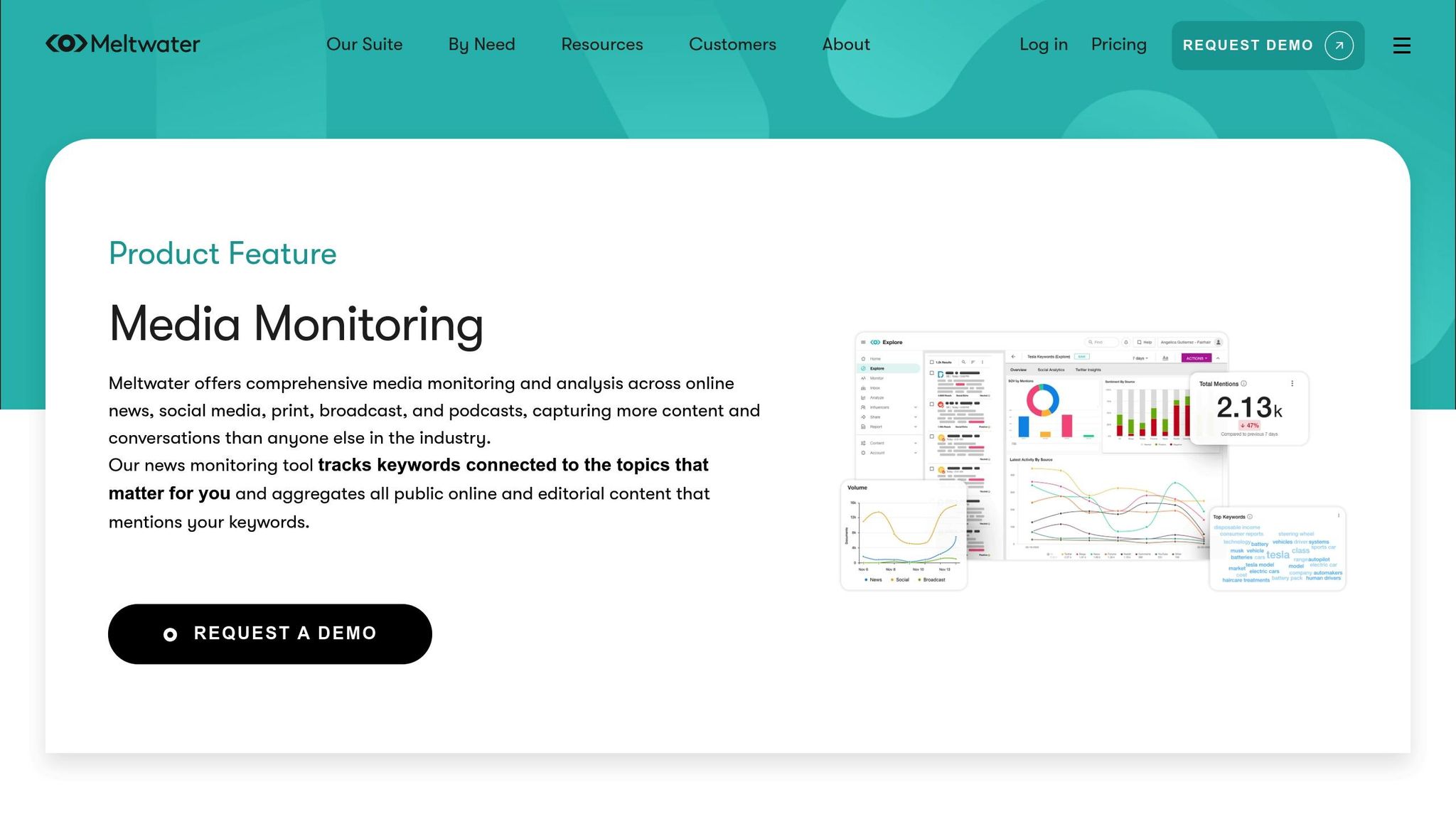
Meltwater offers a blend of traditional media monitoring and social listening, covering 270,000 global news sources and 15 social media platforms. Its advanced search capabilities, including visual analytics operators and case-sensitive searches, provide detailed insights, though they may take time to master. Meltwater tracks multiple engagement metrics and allows for customizable reporting, making it an excellent choice for agencies managing multiple clients. The platform also bridges PR efforts with influencer content collaboration. Despite its extensive features, some users find it challenging to navigate and time-intensive to learn. Meltwater has a 4.00/5 rating from 2,283 reviews.
Mention
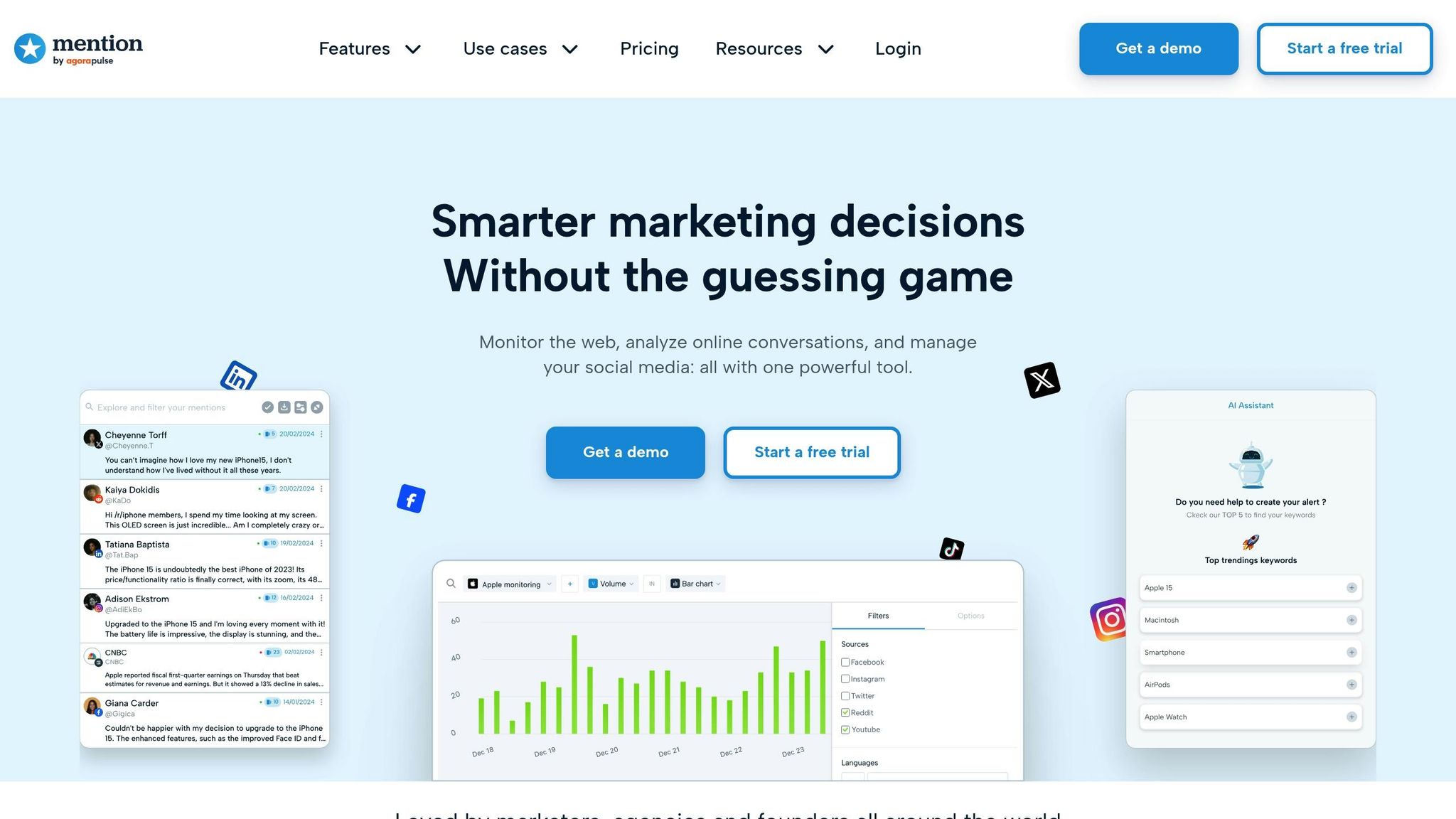
Mention specializes in real-time monitoring, delivering immediate alerts and sentiment analysis with an 82% accuracy F1 score. Startups and small teams often favor Mention for its affordability and ease of use. It handles social media, review sites, news, and forums, while also providing efficient post-performance tracking. However, its analytics are more limited compared to enterprise-level tools, and some users have noticed a decline in result quality over time. Still, Mention remains a practical option for smaller organizations with modest monitoring needs.
Side-by-Side Comparison
Here’s a quick overview of the tools, their features, pricing, strengths, and limitations:
| Tool Name | Key Features | Pricing (USD) | Strengths | Limitations | Best For |
|---|---|---|---|---|---|
| Media AI | AI-powered database, filtering | $99‑$149/mo | Easy to use, no contracts | Limited to media campaigns | PR and influencer work |
| Brandwatch | Social listening, AI insights | Custom | Deep analytics, historical data | High cost, technical issues | Large-scale campaigns |
| Meltwater | PR & social monitoring, reports | Custom | Broad coverage, AI integration | Steep learning curve | Agencies & brands |
| Mention | Real-time alerts, sentiment | Affordable | Budget-friendly, user-friendly | Limited advanced analytics | Startups & small teams |
Each tool offers something unique. Media AI focuses on contact discovery and relationship management, while Brandwatch, Meltwater, and Mention emphasize monitoring and analytics. For smaller teams or those seeking flexibility, Media AI’s pricing and no-contract model stand out. On the other hand, Meltwater is ideal for organizations requiring comprehensive multi-channel monitoring, and Brandwatch is a strong choice for those needing advanced social insights. Mention, with its affordability and real-time capabilities, caters well to startups and small teams.
As Scott Sutton, CEO of Later, explains:
The most successful marketers in 2025 aren't chasing virality - they're building systems that deliver repeatable, measurable value.
Choosing the right tool depends on aligning its features with your workflow. Whether you prioritize outreach, analytics, or affordability, there’s a tool tailored to your needs.
Final Recommendations
By the end of the year, brands are being mentioned every 3.2 seconds across 2.5 million publications. This makes it clear that US professionals need effective tools to keep up with the rapid pace of media coverage.
For PR and influencer marketers, Media AI offers a practical solution priced between $99 and $149 per month, with no long-term contracts. What sets Media AI apart is its robust database of over 30,000 journalist and creator contacts, powered by AI. Unlike competitors that focus heavily on analytics and monitoring, Media AI emphasizes building meaningful media relationships - without the complexity or high costs typically associated with enterprise-level platforms.
Budget considerations play a big role when choosing the right tool. Enterprise solutions like Brandwatch and Meltwater often come with steep price tags, making them less accessible for startups, freelancers, and small agencies. Media AI’s straightforward pricing structure fills this gap, offering a budget-friendly option that aligns with the needs of smaller-scale operations.
The size and complexity of your organization will ultimately determine which tool works best. Large enterprises running global campaigns may lean toward platforms like Meltwater, which provide extensive media coverage but can be more complicated to manage. On the other hand, many US-based PR professionals find greater success with specialized tools that focus on their specific needs rather than trying to do it all.
Data-driven strategies remain critical. PR professionals using these methods are 2.5 times more likely to secure larger budgets. Media AI supports this trend by prioritizing accurate contact information and fostering stronger media relationships, helping users go beyond basic monitoring to achieve meaningful engagement.
Before committing to any tool, take advantage of free trials and demos to see how well it fits your workflow. Evaluate factors like user-friendliness, integration with your existing systems, and scalability. Media AI’s no-contract model is particularly appealing for US professionals who prefer flexibility over the rigid annual commitments required by many enterprise platforms.
For most US-based PR and influencer marketing professionals in 2025, Media AI offers a well-balanced approach - combining functionality, affordability, and ease of use. While larger organizations may benefit from comprehensive monitoring platforms, specialized tools like Media AI often deliver better results for targeted outreach and relationship building.
FAQs
What should I look for in a media monitoring tool to improve my PR strategy in 2025?
When choosing a media monitoring tool for your PR strategy in 2025, focus on tools that deliver broad coverage, real-time updates, and precise data analysis. These features ensure you stay informed about the latest mentions and trends that impact your brand.
Make sure the tool includes customizable reporting, engagement metrics, and smooth integration with your current PR and marketing systems. It’s also helpful if it can track specific keywords, offer competitive insights, and fit within your budget, which might range from $500 to over $10,000 per year.
To get the most value, set clear objectives and filter out irrelevant data, allowing you to zero in on the insights that truly matter for your campaigns. By focusing on these aspects, you'll be better equipped to track media trends and fine-tune your outreach efforts.
What makes Media AI stand out from other media monitoring tools in terms of features and pricing?
Media AI offers a range of AI-powered tools that truly elevate media monitoring. With features like real-time sentiment analysis, automated trend spotting, and influencer identification, it delivers insights that help businesses stay on top of media coverage, gauge audience perceptions, and fine-tune their strategies with precision.
On the pricing front, Media AI keeps things flexible to meet different needs. Plans start at approximately $200 per month, making it a practical option for small businesses. For larger organizations, scalable packages are available to handle more demanding requirements. This blend of advanced tools and cost-effective pricing makes Media AI a go-to solution for professionals looking to monitor media effectively without breaking the bank.
Why is AI-driven sentiment analysis an essential feature in media monitoring tools for PR professionals?
AI-powered sentiment analysis plays a key role for PR professionals by offering real-time insights into how the public feels about a brand. This allows teams to spot potential crises early and take swift action to safeguard the brand's reputation. By examining emotions in media coverage, social media, and other platforms, PR teams can address issues before they spiral out of control.
It also helps professionals gauge consumer opinions and monitor changes in how the brand is perceived over time. Armed with this information, PR teams can make informed decisions, ensuring their strategies resonate with their audience and remain effective in today’s fast-moving digital world.




